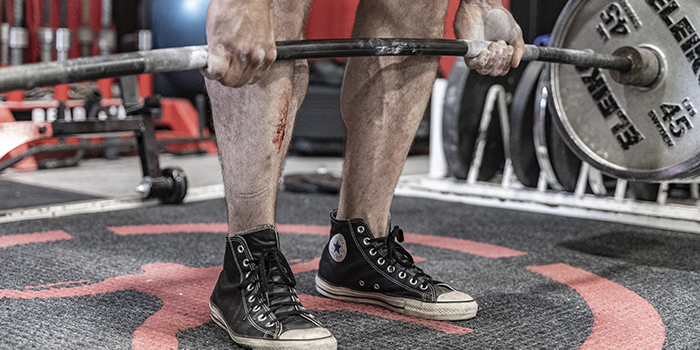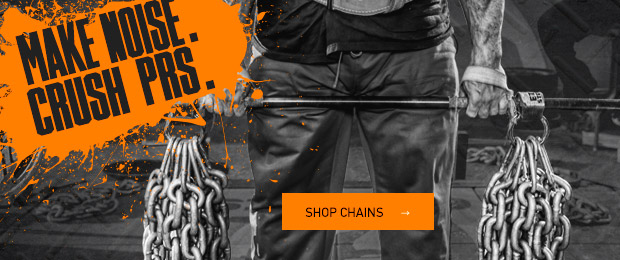
The deadlift has been around since someone put a loaded bar on the ground. Over time some myths have developed, and I am here to bust those myths. After reading this, some of you may feel shocked, lied to, or even angry, and that's ok. These deadlift myths have been around a long time and won't disappear without spreading the truth.
Make deadlifting great again!
7 Deadlift Myths—BUSTED!
Bloody Shins Are a Badge of Courage
Bloody shins are not a badge of courage! You indeed want to keep the bar close to you. You may even hit your shins when pulling, but it's not required for a big deadlift. Starting with the bar too close to the shins may require you to keep the hips too high, or the bar must travel away, making the lift much harder. The setup is the key to a strong, smooth deadlift.
When setting up to deadlift, the bar should line up with the front of the quads, where it will end up at lockout. As you pull back, the lift will be much smoother with an optimal bar path. Once you have your distance set you can line the bar up on your shoe eyelet to replicate that position. Dragging the bar up the shins causes friction and makes the bar move slower. Set up optimally to give yourself the best chance at a successful lift.
Deadlifting is a Back Movement
When you deadlift big weights, you need a strong back. The back needs to maintain proper positioning to keep the spine safe. Moving the bar from the floor to lockout will be done with the quads, hamstrings, and glutes. The deadlift lockout may be assisted with the back, but this is pulling backward, not up. There is a large difference in lifting the weight up and pulling the weight backward.
I understand that the lats, traps, spinal erectors, and rhomboids will all be doing large amounts of work, but they are not the prime movers. This is why the best deadlifters have the strongest hamstrings. If a person gets into a poor starting position or lacks certain areas, the back may do more work, but that should not be the goal. Lifters with a longer torso will also typically find their back will require more work than those with a shorter torso, but again, that is to keep proper positioning. Spinal movement should be very little compared to the knees and hips.
You Need to Perform the Competition Deadlift From the Floor to Make Progress
The statement made by Louie Simmons years ago about not deadlifting was not a lie. Unless you knew exactly what he meant, you might be confused when you see videos of lifters doing deadlift variations on max effort and dynamic effort days. The statement means that normal competition deadlifts from the floor are not needed to make deadlift progress.
Making progress on the deadlift does not require you to do a competition-style deadlift. Dynamic effort deadlifting reinforces your technique with sub-maximal weights. A combination of bar weight and bands or chains can be used after dynamic effort squatting. Eight to ten singles done with short rest periods will keep you explosive. Max effort day is where you learn to strain. Use a variation of the deadlift (i.e., rack pulls, deficit deadlift, opposite stance) on some but not all max effort workouts—you will max out on one of those exercises. If you keep breaking records on the exercises, you are on the right track.
You Should Copy the Best Deadlifter's Technique
There are many great lifters out there. But the very best shouldn't always be copied! The very best deadlifters are most likely not built like you and can get away with things you can't. Taking strengths, weaknesses, body structure, training style, and every other variable into consideration, you are not the same. The concept of trying to mimic a record-holding lifter's technique is great in theory.
When there is just a handful of lifters successfully performing the lift with a style outside the optimal way, you should avoid it. I've seen the strongest guys pull with rounded upper backs. I've also seen them jerk the bar without pulling out all the slack. They are built to deadlift and have found a way to get away with it. You are not them! Use a technique that is ideal. When you perfect the optimal technique, you can try and make adjustments to perfect your style.
If You Use Straps, You'll Lose Grip Strength
Many powerlifters are afraid to deadlift with straps for fear of losing their grip strength. If you used straps for every set of every exercise, that might possibly happen. During the off-season, I might encourage lifters to use straps.
When doing heavy rows and using a double overhand grip on deadlifts before adding straps, you can keep your grip strong. This will keep your grip strong enough until you start meet prep.
The reason for this recommendation is for back health. When using a mixed grip, you will develop one side of your back more than the other. This will help even out back development. Don't ditch the straps; they may prolong your career.
Sumo is Easier or Cheating
I get why people say the sumo deadlift is easier. Sumo deadlifting can look easier because it is a very technical lift, and you don't see people muscling it up. When done correctly, it will be very smooth and look to take less effort. In most cases, if the bar breaks the first three inches off the floor, the likelihood of the lift being completed is high. Where many struggle with the lockout or near the knee in the conventional deadlift, you don't see it as often with sumo deadlifts. So if you struggle at lockout with the deadlift, maybe you need to give sumo a shot.
Powerlifting is not about making things harder or easier. It is about putting up the biggest lifts within the rules of your federation. My question for those who say it is cheating would be, if you can lift more weight safely within the rules of competition, why wouldn't you? There is no asterisk next to the names of those who deadlift sumo. If you are losing to those pulling sumo and are mad about it, maybe you need to look in the mirror.
Rack Pulls Will Fix Your Lockout
As soon as someone misses a deadlift above the knees, they immediately think they need to load up a bar and start knocking out heavy rack pulls. The lifter uses a weight at or near their max deadlift with no problem. It might be challenging, but their technique flaw is now gone. I have never prescribed above the knee rack pulls for a client. Not to say there isn't some value in them; however, to fix the lockout problem, you need to look at why you're missing, not just where you're missing.
Many deadlifts at lockout are missed due to a setup, technique, or speed issue. You shouldn't be using your back to finish a deadlift after your legs have locked out prematurely. I said it above, and I will say it again. The deadlift is a hamstring movement. A bad setup and start often leads to the bar getting away from the lifter; therefore, the legs/glutes lock out well before they should. You will then not have anything left to finish the lift. Start better to finish better.
The deadlift takes attitude and technique. There are myths surrounding the deadlift that might be holding you back. Change your thinking and let go of old beliefs that might be incorrect. Fix these areas, and your deadlift will improve.
Matt Ladewski has been involved in the sport of powerlifting for over 20 years. As his pursuit of bigger numbers of his own has concluded, his attention has shifted to coaching his athletes, including a WPF and an AWPC champion. As a columnist for elitefts, Matt shares his training knowledge and experience as he writes about both his own training and the coaching of his athletes. Matt's best competition lifts include an 835-pound squat, a 550-pound bench press, and an 800-pound deadlift.











2 Comments